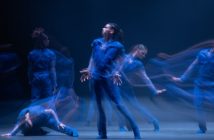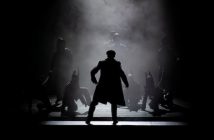Childish excitement was the flavour of the day preceding my visit to Sadler’s Wells for Rambert Dance Company’s latest triple bill. Founded over 80 years ago and carrying with it a well-deserved reputation as one of the glittering vertebrae in the backbone of contemporary dance, the bar is set perilously high for this dynamic company. In recent months, brutal cuts in arts funding has seen the many pioneering companies under the pressure of governmental tight-fistedness, but Rambert is, miraculously, about to open new studios on South Bank, albeit with a budget as lean as one of their dancers. If there was ever a time for this company to prove its worth, that time is now.
Rambert’s latest oeuvre features their usual melting pot of diversity – artistic director Mark Baldwin has the uncanny knack of putting together a kind of pick’n’mix of kinetic morsels – by the end of the night one piece has usually whetted your appetite. RainForest opened the evening’s performance, choreographed by the Prince of contemporary dance, Merce Cunningham. As the curtain rose, I am not ashamed to say I nearly jumped out of my seat at what I could only presume were three stark naked beings on the stage. My mind was racing to recall a possible missed footnote about adult themes and nudity…until I realised they were, thankfully (or not, depending on your levels of perversion) clad in flesh-coloured unitards, a look that hard-bodied waifs only can carry off with panache. Scattered around these nude pretenders were helium-filled silver pillows, designed by Andy Warhol, no less, back in the day when it was cool to collaborate with choreographers. More recently, for some reason, the union of Julian Opie and Wayne MacGregor has been the sole rock ‘n’ roll collaboration of the dance world, and what a collaboration it was. Warhol’s surreal, effortlessly cool design served as a timely reminder of the wonderful things that can be achieved in theatre when the big boys all play nicely together.
The dancers wriggled and undulated their way through the piece with understated precision, all to a brain-gratingly annoying soundtrack of ‘dischordantly’ electronic noise. As the piece progressed, it slipped into choreography more easily identifiable as Cunningham’s, as surges of energy and drive ate up the stage, spiced up with a healthy dose of animalistic interaction. For those who are not disciples of Cunningham, I may have lost you already. If you are the kind of theatre-goer who likes their evening fuelled with narrative, emotion and spectacle, RainForest will feel like the theatrical equivalent of a three hour conference on health and safety regulations. This really is a study in the possibility of movement: fundamentally, it is dance for dance’s sake. To truly enjoy RainForest, a childlike fascination in the physics of balance, the limits of strength and the theatrical ethics of aesthetics are essential.
After a leisurely interval of alcoholic fortification (one of the best things about triple bills – double the intervals, double the vino opportunities!), we returned for Seven for a secret, never to be told, choreographed by Mark Baldwin, and making its debut in London this week. It was such a shift in style, you would be forgiven for thinking you had got a little carried away at the bar and walked into a different performance. Full of spritely joy and childish wonder, the dancers cavorted around a stage swathed in soft green material, providing a woodland setting for this episodic exploration of juvenile mentality. Baldwin indulged us with some slapstick-driven chuckles, with choreography reminiscent of David Bintley’s Midsummer Night’s Dream in its boundless energy and comic persuasion. However, the subject matter really does have its limitations, and unless you’re the type who has a predilection for watching videos of cats playing the piano on YouTube, this sugary childishness gets pretty boring, pretty quickly. Keep an eye out, though, for the stunning virtuosic solos from Dane Hurst, whose spring-loaded jumps are so remarkable, they almost defy belief. Add to that an enchanting pixie-like presence, and Hurst really saves the final moments of the piece from slipping into hum-drum nursery school territory.
Finishing off the evening’s entertainment was the world premiere of Javier de Frutos’ Elysian Fields, a piece based on the life and works of Tennessee Williams. It started very promisingly; a broodingly dark and stylised stage, filled with Southern Belles and aggressive testosterone-fuelled men. While snippets of A Streetcar Named Desire were read aloud (on-stage by various dancers) a single female dancer interpreted the rhythm and meaning of Williams’ words with mesmerising fragility. If only the whole piece had stayed just like this. Alas, it descended into a writhing mass of shouting, stage-fighting bodies, screaming and gesticulating wildly, kissing and caressing, but rarely conveying any real eroticism or emotion. It had all the wild melodrama of Matthew Bourne’s Car Man, but somehow managed to be not even half as affecting.
The choreography of the performances didn’t fully exploit the dancers’ formidable talents, but watching Rambert is never going to be an arduous task; they are a company of some of the finest contemporary dancers in the country, and their astounding ability is reason enough to see any show.
Rambert Dance Company is at Sadler’s Wells Theatre until Saturday 19th November (tickets available from www.sadlerswells.com) and is subsequently touring the UK until May 2012 (see www.rambert.org.uk for details).





2 Comments
Wow this is the first dance review I have read in a long time that has managed to hold my interest and give me useful information at the same time! Great narrative voice 🙂
Great article. Look forward to reading more of these! Money well spent!